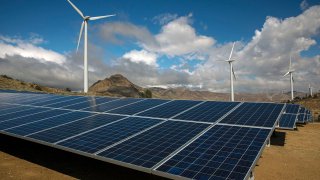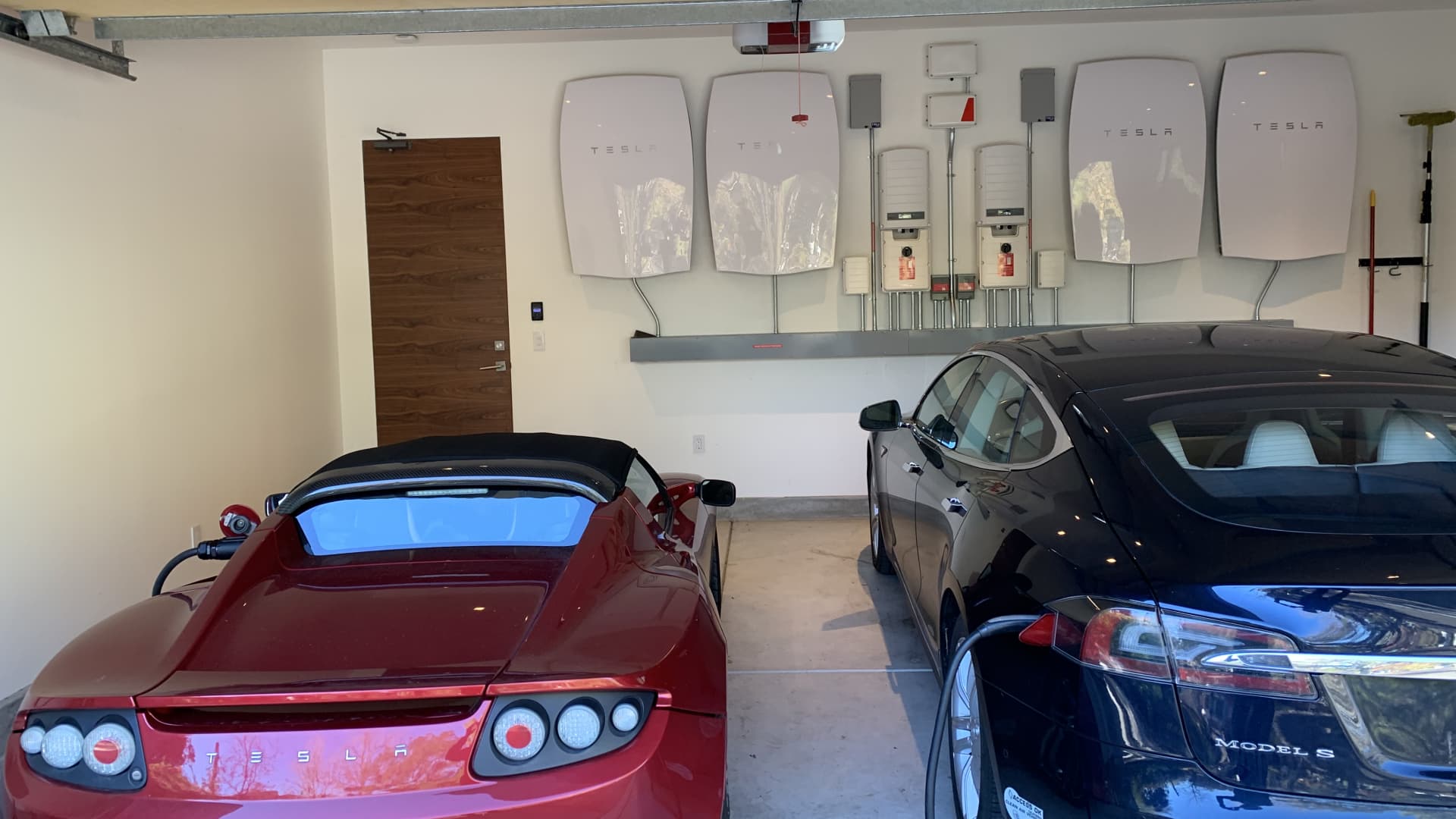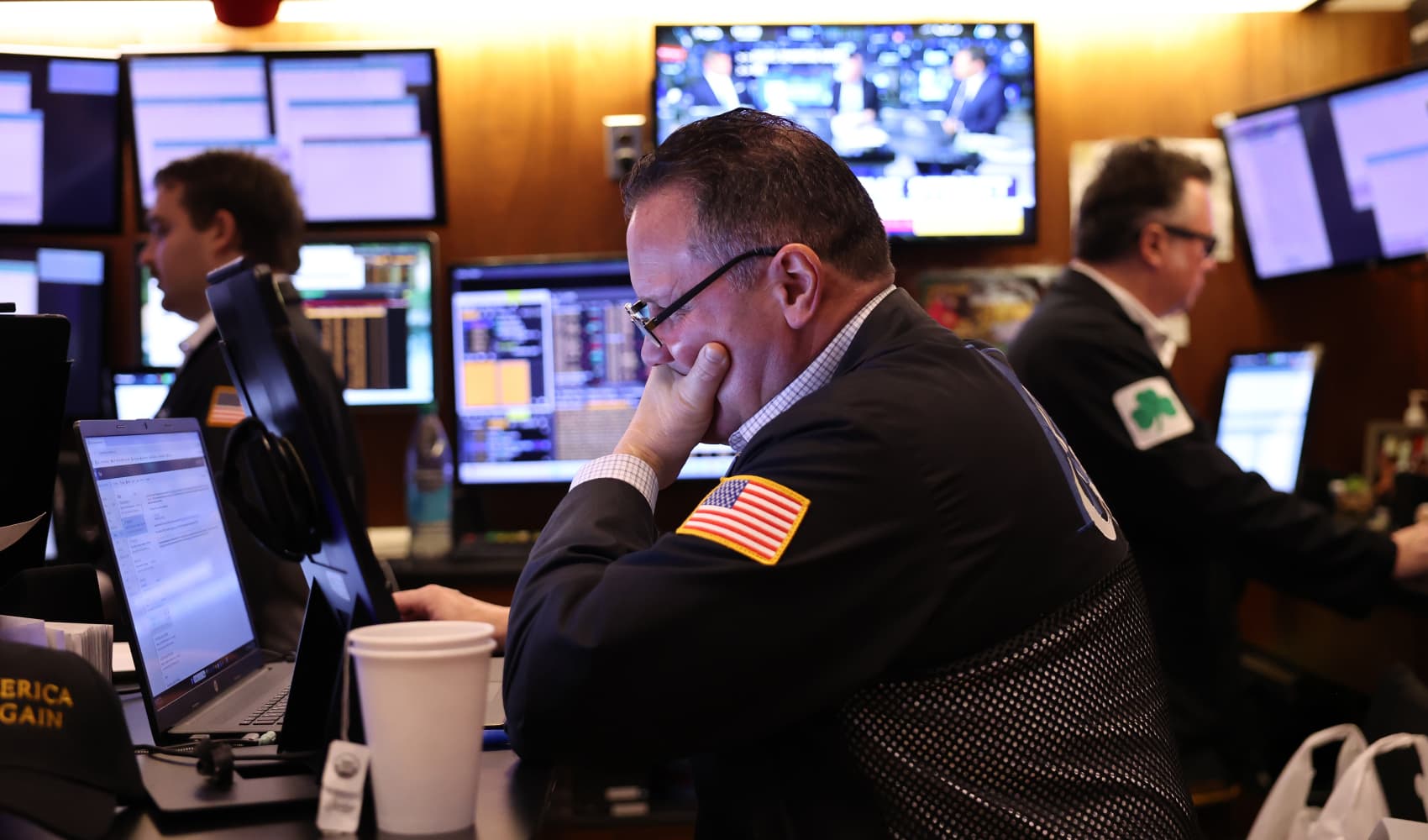
LADWPs Pine Tree Wind Farm and Solar Power Plant in the Tehachapi Mountains Tehachapi Mountains on Tuesday, March 23, 2021 in Kern County, CA.
- Stanford professor Mark Jacobson sees a way for the U.S. to meet its energy demands by 2050 with 100% wind, water and solar.
- His models use no fossil fuels, carbon capture, direct air capture, bioenergy, blue hydrogen or nuclear power.
- Jacobson's roadmap is different from many clean-energy proposals, which advocate using all technologies possible.
A prominent Stanford University professor has outlined a roadmap for the United States to meet its total energy needs using 100% wind, water and solar by 2050.
Mark Jacobson, a Stanford professor of civil and environmental engineering and the director of its Atmosphere/Energy Program, has been promoting the idea of all renewable energy as the best way forward for more than a decade. His latest calculations toward this ambitious goal were recently published in the scientific journal Renewable Energy.
Transitioning to a clean-energy grid should happen by 2035, the study advises, with at least 80% of that adjustment completed by 2030. For the purposes of Jacobson's study, his team factored in presumed population growth and efficiency improvements in energy to envision what that would look like in 2050.
Get top local stories in Philly delivered to you every morning. Sign up for NBC Philadelphia's News Headlines newsletter.
Jacobson first published a roadmap of renewable energy for all 50 states in 2015.
This recent update of that 2015 work has a couple of notable improvements.
Money Report
First, Jacobson and his colleagues had access to more granular data for how much heat will be needed in buildings in every state for the coming two years in 30-second increments. "Before we didn't have that type of data available," Jacobson told CNBC.
Also, the updated data makes use of battery storage while the first set of calculations he did relied on adding turbines to hydropower plants to meet peak demand, an assumption that turned out to be impractical and without political support for that technology, Jacobson said.
Reliability of four-hour batteries
In the analysis, Jacobson and his team used battery-storage technology to compensate for the inherent intermittency of solar and wind power generation — those times when the sun doesn't shine and the wind doesn't blow.
The Achilles' heel of a completely renewable grid, many argue, is that it is not stable enough to be reliable. Blackouts have become a particular concern, notably in Texas this year and during the summer of 2020 in California.
That's where four-hour batteries come in as a way to generate grid stability. "I discovered this all just because I have batteries in my own home," Jacobson told CNBC. "And I figured, oh, my God, this is so basic. So obvious. I can't believe nobody has figured this out."

Jacobson said that he observed his batteries stayed charged if they weren't plugged in when they are off.
To get more than four hours of charge, multiple four-hour batteries can be stacked to discharge sequentially. If a battery needs more charge output at one time than the battery can provide, then the batteries need to be used simultaneously, Jacobson told CNBC.
With this observation, Jacobson and his colleagues at Stanford produced scenarios showing it is possible to transition to a fully renewable system without any blackouts or batteries with ultra-long-duration battery technology.
That's key because technology for ultra-long-duration batteries that would hold energy for several days have yet to be commercialized. Start-ups like Form Energy are working to bring such batteries to market.
Planning, of course, is also key to keeping the grid stable. "Wind is variable, solar is variable," Jacobson said. "But it turns out, first of all, when you interconnect wind and solar over large areas, which is currently done, you smooth out the supply quite a bit. So it's because, you know, when the wind is not blowing in one place, it's usually blowing somewhere else. So over a large region, you have a smoother supply of energy."
Similarly, wind and solar power are complimentary. And hydropower "is perfect backup, because you can turn it on and off instantaneously," he said.
Also, there needs to be changes in pricing structures to motivate customers to do high energy demand activities at off-peak times.
"Demand response is a very big component of keeping the grid stable," Jacobson said. "It's used some today. But a lot of places a lot of states in the US right now, the electricity price is constant all day ... and that's a problem."
Calculating the breakdowns
So far, Jacobson and his team have run simulations for the all renewable, four-hour battery roadmaps for six individual states – Alaska, Hawaii, California, Texas, New York and Florida, and the contiguous 48 states taken together. (For the rest of the states, Jacobson has approximate simulations, which are available here.)
According to his models, California's energy mix would include 14.72% on-shore wind energy, 18.28% off-shore wind, 21.86% solar panels on roofs, 34.66% solar panels operated by a utility, 5.32% hydropower, 2.91% geothermal electricity and 0.25% wave energy.
Texas would be 37.66 on-shore wind, 14.77% off-shore wind, 20.87% roof solar, 23.85% solar panels operated by a utility, 0.1% hydropower and 0.19% wave energy.
Jacobson and his colleagues use three types of models for the calculations.
First, they use a spreadsheet model to project business-as-usual energy demand in each sector in each state to 2050 and then to convert the business-as-usual energy demand in 2050 to electricity provided by wind, water and solar.
Second, they use a weather model to predict the wind and solar fields in each state every 30 seconds. This weather-prediction model runs on a supercomputer and is written in Fortran computing language.
And the third component of his modeling matches the 2050 energy demand with the weather modeling of energy that can be supplied from wind, water and solar every 30 seconds. The third component is also written in Fortran, but this portion of the process can run on virtually any computer.
The resulting models use no fossil fuels, carbon capture, direct air capture, bioenergy, blue hydrogen or nuclear power.
And in that, Jacobson's roadmaps are different from many clean-energy proposals, which advocate for using all technologies possible.
"So we're trying to eliminate air pollution and global warming, and provide energy security. So those are the three purposes of our studies," Jacobson told CNBC. And that "is a little different than a lot of studies that only focus on greenhouse gases. So we're trying to eliminate air pollution as well, and also provides energy security."
Addressing all three issues has been Jacobson's focus for more than a decade. His first major work in the area was published in 2009 in Scientific American magazine, and four years later he appeared on NBC's "Late Night with David Letterman" to promote his renewable-only approach. Jacobson and longtime progressive political candidate Bernie Sanders co-authored a clean-energy op-ed in The Guardian in 2017.
Combating fears of blackouts
Jacobson knows that his viewpoint is not the loudest. The promise of next-generation nuclear power plants, for example, has gotten government and private funding of late.
Nuclear innovation is "pushed mostly by the industry people, people like Bill Gates, who has a huge investment in small modular reactors," Jacobson said. "He has a financial interest. And he wants to be known as somebody who tries to help solve the problem."
Gates addressed the criticism that he's a "technocrat" looking to solve climate change with new innovations, instead of with political legislation supporting technology like wind and solar which already exists, in an interview with Anderson Cooper on CBS' "60 Minutes" earlier in the year. "I wish all this funding of these companies wasn't necessary at all. Without innovation, we will not solve climate change. We won't even come close," Gates said.
Also, the timeline for getting some of these technologies to commercialization is too long to be useful. Gates' advanced reactor company, TerraPower, announced in November that it has chosen the frontier-era coal town Kemmerer, Wyoming, as the preferred location for its first demonstration reactor, which it aims to build by 2028.
"Even if it's seven years, that's just a demonstration plant," Jacobson said. "That's not even close to a commercial plant and on the scale we need."
TerraPower CEO Chris Levesque said the technology, specifically the Natrium nuclear reactor, will make a meaningful difference in combating climate change.
"The Natrium technology was chosen as the first mover of TerraPower's technologies because we believe it will be operational in time to offer significant benefit toward the country's decarbonization goals," Levesque said in a statement.
Winning over clean-energy skeptics afraid of blackouts is a challenge, but Jacobson believes he can convince people to accept that a future like he has modeled is possible.
Renewable solutions for long-distance ships and aircraft are not available yet, he said. "But those are on the drawing board. And we know technically it can be done just as those haven't been commercialized."
Education is a key hurdle, as Jacobson sees it. "I am optimistic. But the thing I find that's the biggest difficulty is the fact that it is an information issue, because most people are not aware, most people are not aware of what's possible," he said.






